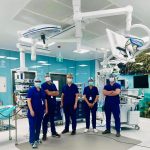SOLUTIONS ACCORDING TO HYGIENE STANDARDS
Since 1987 ATA has gained rich experience in designing and marketing air treatment solutions for all areas where infection risk tends to occur. ATA proposes a range of hygienic products which corresponds to all requirements of hospital and industrial sectors, where standards have to be strictly respected.
In continued cooperation with University research centres in France, ATA stays also updated about the latest technologies to offer customers the custom made solutions they need.
The NFS 90 351, such as the NF EN ISO 14644-1 are the guidelines to ATA’s solutions development for now 30 years.
ISO standards defines the risks incurred in the controlled area and classify those areas into different classes. For each risk zone, ISO standards specify technical performances to be achieved. Patient risk assessment must take into account the patient’s condition, act, actors and the environment. The risk class has to be related to the particulate, microbiological and aeraulic performances of an area defined in the following tables.

The ISO standard classifies clean rooms into different classes. For each risk zone, the ISO standard indicates the technical performance to be achieved.
Among them,
Particulate Class is defined by standard NF EN ISO 14644-1 according to the size of the particles present in the air.
PARTICULAR AIR DECONTAMINATION CLASSIFICATION ACCORDING TO 14644-1

c: The maximum admissible conditions do not apply in this part of the table because they are very high.
d: The sampling limits and the statistical limits on these low concentrations make the classification inappropriate
e: The limits of sampling mechanisms, due to both the low concentrations and the sampling of particles larger than 1 µm, make the classification inappropriate because of the particles potentially not measured, as they are retained inside the sampling system.
Decontamination kinetics class: Particles decontamination kinetics at a level of 0,5 micron/m3 is set by the time necessary to reach a 90{01e3c5e93231d16e008ef94f2b1d6fd0127ff363a7cc717001d1444d838f865e} decontamination rate from the initial pollution peak level. For example, CP 10 means that it requires 10 min to reach 90{01e3c5e93231d16e008ef94f2b1d6fd0127ff363a7cc717001d1444d838f865e} decontamination rate.
Bacteriological class: it indicates the maximum concentration of number of viable particles per cubic meter of air (cfu/m3). For example, M10 means that this level accepts a maximum concentration of 10 viable particles per cubic meter of air (cfu/m3) .

The following tool provides a risk class correspondence for each type of activity: it is not exhaustive and does not replace a risk analysis. By choosing the activity practiced in the controlled area in the tool below, you will find the solution ATA can provide you.
Solutions that require air handling units will nevertheless need further studies on the project. Additional performances need to be reached to control the whole area: pressure, air flow rates, fresh air rates, humidity and temperature.
How to get a whole custom solution for air treatment from ATA ?
Unlike air handling units, the mobile units can’t control such performances, which mainly rely on these information :
– Volume of the controlled area
– Temperature and Humidity outside (Summer / Winter)
– Place of the air treatment device
– Type of cooling : DX chiller or Chilled water.
Once we obtain these information, your budget and deadline, ATA is committed to give you a return as soon as possible.
The solution we offer require excellent implementation, perfect processing and precise knowledge of materials. To be successful in this combination, we show great flexibility, with qualified staff and advanced manufacturing technologies.




